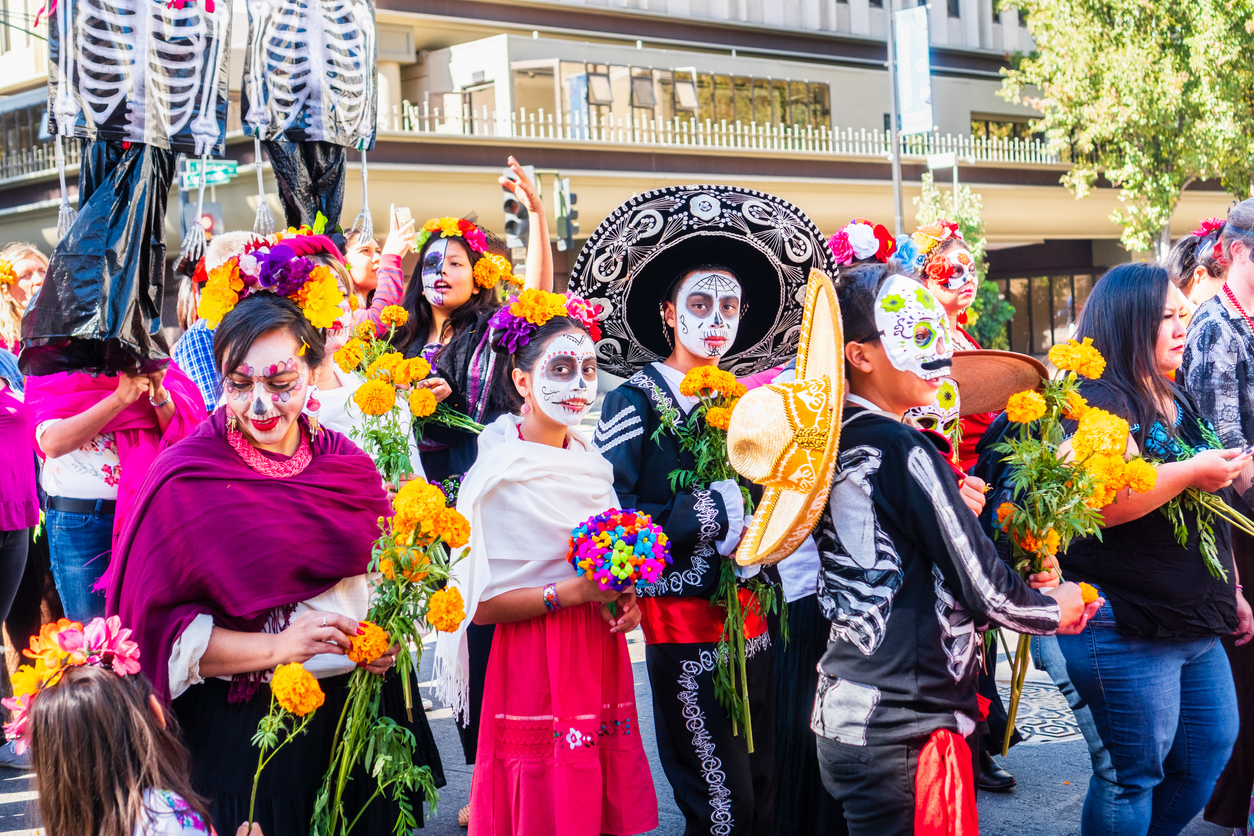
Day of the Dead for Students
With the popularity of movies like Coco and The Book of Life, students are undoubtedly more curious about the Mexican holiday the Day of the Dead, or Día de Los Muertos, (sometimes referred to as Mexican Halloween) than they were a decade ago. The appearance of skulls, face paint, and skeleton folk art on clothing and decor have become widespread in recent years, and many of the skeletons seem joyful. Kids are naturally curious. Who wouldn’t want to know why all those skeletons appear so happy? Why is Día de los Muertos considered a celebration- not just in places like Mexico City, but everywhere?
Many students (and many others!) may confuse the Mexican tradition of celebrating the Day of the Dead with Halloween, but the holiday falls on November 1st and 2nd. There is certainly a connection to Halloween, which originates from All Hallows’ Eve, or the night before All Saints Day, part of the Roman Catholic tradition. With the holidays falling so close, it is easy to see how they are often associated together.
"They believed life and death were a natural part of the life cycle and meant to be celebrated."
Origins of Day of the Dead
The idea of celebrating loved ones who have passed comes from the traditions of native people, such as the Aztecs, Maya, Olmec, and Toltecs, of what is now Mexico and Central America. They believed life and death were a natural part of the life cycle and meant to be celebrated. Traditions among different groups varied, but all shared the concept of an afterlife.
When Spanish conquistadors arrived in Mexico in the sixteenth century, they brought their Catholic faith with them, which included the celebrations of All Saints Day and All Souls Day. The current Day of the Dead celebrations results from the intermingling of native Central American and Catholic traditions.
The concept of the days-long Día de los Muertos celebration has travelled out of Mexico and other countries in Latin America to countries worldwide, bringing with it interest and appreciation for traditional Mexican and Latin American culture and traditions. You can find more about Day of the Dead origins here.
"Today, November 1st is dedicated to honoring the children who have died. November 2nd is reserved to honor the adults who have passed."
Day of the Dead Today
Today, November 1st is dedicated to honoring the children who have died and is often called El Día de Los Angelitos (Day of the Little Angels). November 2nd is reserved to honor the adults who have passed.
In Central America and the US, Latino families gather to prepare for the holiday several days in advance. Preparations first include cleaning the grave site of loved ones and the home. They will then prepare favorite foods such as mole and pan de Muerto (bread of the dead), also called sweet bread. In many homes, an altar called an ofrenda is decorated with marigolds (or cempasuchil), photos of deceased family members, and other offerings for the dead. Family members will also decorate and place offerings for the dead at their grave sites. They believe that the spirits of their deceased relatives will visit on the Day of the Dead because the offerings entice them to return. Some families will spend most of the night in the cemetery singing, eating, and drinking to celebrate the spiritual return of their loved ones.
Celebrating in the Classroom
While the topic may be intimidating at first to attempt to cover in the classroom, there are some beautiful, kid-friendly day-of-the-dead crafts you can include in your plans. Some traditional Day of the Dead decorations includes Papel Picado (cut tissue paper), Calaveras (sugar skulls), and cempasúchitl (marigolds). Depending on your resources, you may want to try making one or more of these with your students. Cutting tissue paper may be too intricate for younger students, but templates can make the task easier. You can also copy templates of skeletons and skulls for students to decorate. They are much less expensive and not nearly as messy as the delicate sugar skulls. A more involved project for older students is to create papier-mâché skulls. You will need to set aside time over a few days to complete the project. Making marigolds out of crepe paper is a relatively easy task for upper elementary through high school-aged students, who often enjoy creating the much-recognized La Catrina skull, famously wearing a crown of flowers.
If you would like to make some literary connections, you may want to introduce your older students to Calaveras literarias, poems that were originally written to poke fun at death. Students can create poetry based on examples or write poems and stories about the holiday. No matter what your students make, reserve a place in the classroom to show off their projects. Or, you can use something as simple as a reading passage that will help build vocabulary and awareness. A picture book written by Bob Barner titled “El dia de Los Muertos” would also be a great addition to elementary grades studies.
Most students are visual learners these days. It would help to accompany your lesson and/or unit of the dia de Los Muertos celebration with some videos and connecting printable activities. Sometimes something as simple as coloring pages enable students to make deeper connections.
Related resources: Day of the Dead Activity Hub
"Family members decorate and place offerings for the dead at grave sites. They believe that the spirits of their deceased relatives will visit on the Day of the Dead because the offerings entice them to return."
Death Can Be a Scary Topic
Depending on your students’ ages, they may find it confusing or disturbing that the Day of the Dead is a truly joyful celebration. They may view death as scary or sad, although modern American traditions often include a more cheerful tone, such as a celebration of life rather than a funeral. The idea of family members throwing a fiesta at the cemetery may also be disturbing to some of your students.
Be sure to respect their feelings while asking them to keep their minds open to new and different traditions.
Some students may be enthusiastic about sharing their families’ traditions regarding death and honoring deceased loved ones; others may have little or no experience losing a family member. And indeed, be aware that one or more of your students may have recently lost a loved one.
Community Celebrations
If you live in or near an urban area or have an active local Latino community, you may find Day of the Dead celebrations in your neighborhood. Check community calendars to see what may be happening in your area and encourage your students to experience the holiday firsthand if they can.
Introduce the history, traditions, and symbols of Día de los Muertos, Day of the Dead, through educational videos and activities using our Day of the Dead Activity Hub.
Sign up to our weekly newsletter for timely and seasonal content tie-ins, including printables, lessons, and holiday activities.










